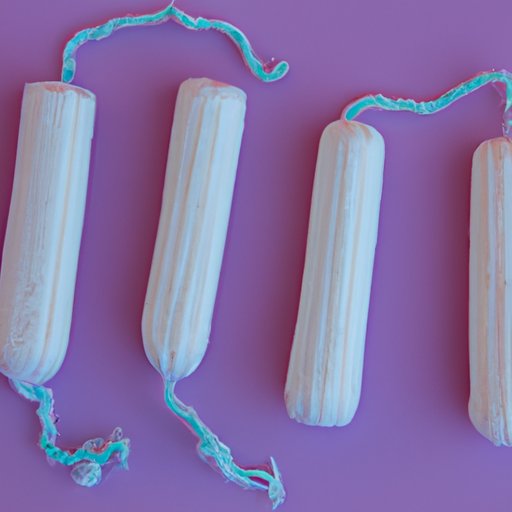Introduction
For many individuals, tampons are a popular choice for menstrual hygiene and convenience. However, if you are new to using this type of menstrual product, you may be unsure of how to use tampons correctly. In this article, we’ll explore a step-by-step guide on how to use tampons, tips for choosing the right tampon for your flow, common mistakes to avoid, and much more. Whether you’re a first-time tampon user or just want to learn more, this article will help you feel confident and comfortable during your period.
A step-by-step guide on how to insert a tampon
Before diving into the step-by-step guide, it’s essential to know the different parts of a tampon, which include the tampon itself, the applicator, and the string.
When inserting a tampon, there are three positions that can be used:
- Sitting on the toilet with knees apart
- Standing with one foot on the toilet seat or a chair
- Lying on your back with knees bent and apart
Now let’s go over the steps for inserting a tampon:
- Wash your hands
- Choose the right absorbency level for your flow
- Remove the tampon from the packaging and hold it by the applicator
- With your free hand, hold the string and gently pull it to ensure it’s secure
- Sit in one of the positions mentioned above
- Relax your pelvic muscles and gently insert the tampon into the vagina, aiming it toward your lower back. The insertion should be smooth and gentle. Do not apply force.
- Once the applicator is inside, use your index finger to push the inner tube up, pushing the tampon into the vagina while still holding the outer tube in place.
- Remove the applicator and dispose of it in the trash, not the toilet
- Check the tampon string, making sure it’s hanging outside of your body
If you experience discomfort or pain while inserting the tampon, try using more lubrication or switching to a different position.
Tips and tricks for choosing the right tampon for your flow
Choosing the right tampon for your flow can make all the difference in feeling comfortable and secure during your period. Tampons come in different absorbency levels, from light to heavy. The absorbency level you choose will depend on the heaviness of your flow. Always choose the lowest absorbency level possible to reduce the risk of Toxic Shock Syndrome.
It’s also essential to consider the features of different tampon brands and types. For example, some tampons have smooth applicators, while others have a grip texture to help with insertion. Some tampons also come with leak protection, which can be especially helpful during heavy flow days.
When selecting tampons, don’t hesitate to try different brands and types to see what works best for you. You may also want to consider purchasing a starter pack that includes different absorbency levels to help you determine which one is right for you.
Common mistakes to avoid when using a tampon
While tampons are a convenient and popular menstrual product, there are common mistakes that people make when using them.
One of the most common mistakes is not changing the tampon frequently enough. Ideally, tampons should be changed every four to eight hours, depending on the heaviness of your flow. Leaving a tampon in for too long can increase the risk of Toxic Shock Syndrome, a rare but serious bacterial infection.
Another common mistake is inserting the tampon too deeply. This can cause discomfort and make it difficult to remove the tampon. Inserting the tampon at a slight angle towards the lower back can help prevent this mistake.
It’s also important to remember always to remove the tampon before having sex or using a menstrual cup since forgetting to do so can lead to complications.
Other common mistakes include using the wrong absorbency level, failing to wash your hands before insertion, and flushing the tampon down the toilet. Remember to always read the instructions carefully and follow them to avoid making these mistakes.
How to feel comfortable and confident while using a tampon
Many individuals may feel anxious or self-conscious when using tampons for the first time. Here are some tips to help you feel comfortable and confident:
- Practice using tampons when you’re not on your period
- Choose a private and comfortable setting to insert a tampon
- Wear comfortable clothing that allows for easy insertion and removal of tampons
- Use a mirror to view the area to help with insertion
- Remember to relax your pelvic muscles when inserting the tampon
- Feel confident in knowing that tampons are a popular and safe menstrual product used by millions of people worldwide.
The benefits of using tampons over other menstrual products
While tampons are not the only menstrual product available, there are several advantages to choosing them over other options. One of the biggest benefits is increased mobility and freedom. Unlike pads, tampons do not feel bulky and can be worn comfortably during exercise, swimming, and other physical activities.
Tampons are also incredibly discreet and can be worn with any type of clothing, including form-fitting and tight clothes. This makes them the perfect choice for individuals who prefer a more natural feel without having to worry about visible panty lines or bulky protection.
Furthermore, tampons do not produce waste in the same way that pads and liners do, making them a more eco-friendly choice. They also do not require as much storage space as other menstrual products, which is ideal for individuals who need to travel with minimal supplies.
How to properly dispose of tampons
Proper tampon disposal is essential for maintaining good hygiene and preventing environmental pollution.
When it comes to disposing of tampons, it’s essential to remember not to flush them down the toilet. Flushing tampons can result in clogged pipes and damage to your septic system or wastewater treatment plant. Instead, wrap the tampon in toilet paper or a disposable bag and toss it in the trash.
Some tampons are also designed to be flushable, but you should always double-check the packaging to make sure. Remember to read the packaging of your tampons carefully to ensure that you are disposing of them in the recommended way.
If you’re looking for a more eco-friendly option for tampon disposal, there are reusable tampon applicators available for purchase. These applicators can be washed and reused, reducing waste and helping you save money in the long run.

Frequently asked questions about using tampons and their answers
Q: What is Toxic Shock Syndrome, and how can I avoid it?
A: Toxic Shock Syndrome (TSS) is a rare but severe bacterial infection that can be life-threatening. TSS is caused by bacteria found on the skin, which can enter the bloodstream through wounds, burns, or the vagina. The risk of developing TSS can increase with extended tampon use or failure to change your tampon frequently enough. To avoid TSS, always change your tampon every eight hours or less, use the lowest absorbency level possible, and consider using menstrual cups or pads as an alternative.
Q: How often should I change my tampon?
A: Tampons should be changed every four to eight hours, depending on the heaviness of your flow. Changing your tampon frequently reduces the risk of infection and keeps you feeling comfortable and fresh throughout the day.
Q: Can I swim while wearing a tampon?
A: Yes, tampons are perfect for swimming and other water activities. Tampons are designed to absorb menstrual blood and can be worn discreetly, providing freedom of movement and comfort.
Q: Can using a tampon break my hymen?
A: The hymen is a thin tissue that covers the vaginal opening. While it is possible for a tampon to stretch or tear the hymen, it’s unlikely. In most cases, the hymen is stretched or broken through activities like sports, horseback riding, or sexual intercourse, or it can break on its own due to no reason at all.
Conclusion
Using tampons is an excellent way to have increased freedom and mobility during your period. With this guide, you’ll now have a better understanding of how to use tampons safely and feel comfortable and confident while doing so. Remember to choose the right absorbency level, avoid common mistakes, dispose of tampons correctly, and most importantly, feel confident in knowing that you got this.
Share this article with others who may find it helpful, and remember to always feel empowered and in control while managing your period.
